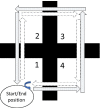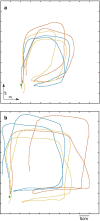Factors associated with dynamic balance in people with Persistent Postural Perceptual Dizziness (PPPD): a cross-sectional study using a virtual-reality Four Square Step Test
- PMID: 33766072
- PMCID: PMC7993529
- DOI: 10.1186/s12984-021-00852-0
Factors associated with dynamic balance in people with Persistent Postural Perceptual Dizziness (PPPD): a cross-sectional study using a virtual-reality Four Square Step Test
Abstract
Background: Persistent postural-perceptual dizziness (PPPD) is a condition characterized by chronic subjective dizziness and exacerbated by visual stimuli or upright movement. Typical balance tests do not replicate the environments known to increase symptoms in people with PPPD-crowded places with moving objects. Using a virtual reality system, we quantified dynamic balance in people with PPPD and healthy controls in diverse visual conditions.
Methods: Twenty-two individuals with PPPD and 29 controls performed a square-shaped fast walking task (Four-Square Step Test Virtual Reality-FSST-VR) using a head-mounted-display (HTC Vive) under 3 visual conditions (empty train platform; people moving; people and trains moving). Head kinematics was used to measure task duration, movement smoothness and anterior-posterior (AP) and medio-lateral (ML) ranges of movement (ROM). Heart rate (HR) was monitored using a chest-band. Participants also completed a functional mobility test (Timed-Up-and-Go; TUG) and questionnaires measuring anxiety (State-Trait Anxiety Inventory; STAI), balance confidence (Activities-Specific Balance Confidence; ABC), perceived disability (Dizziness Handicap Inventory) and simulator sickness (Simulator Sickness Questionnaire). Main effects of visual load and group and associations between performance, functional and self-reported outcomes were examined.
Results: State anxiety and simulator sickness did not increase following testing. AP-ROM and HR increased with high visual load in both groups (p < 0.05). There were no significant between-group differences in head kinematics. In the high visual load conditions, high trait anxiety and longer TUG duration were moderately associated with reduced AP and ML-ROM in the PPPD group and low ABC and high perceived disability were associated with reduced AP-ROM (|r| = 0.47 to 0.53; p < 0.05). In contrast, in controls high STAI-trait, low ABC and longer TUG duration were associated with increased AP-ROM (|r| = 0.38 to 0.46; p < 0.05) and longer TUG duration was associated with increased ML-ROM (r = 0.53, p < 0.01).
Conclusions: FSST-VR may shed light on movement strategies in PPPD beyond task duration. While no main effect of group was observed, the distinct associations with self-reported and functional outcomes, identified using spatial head kinematics, suggest that some people with PPPD reduce head degrees of freedom when performing a dynamic balance task. This supports a potential link between spatial perception and PPPD symptomatology.
Keywords: Anxiety; Chronic dizziness; FSST; HTC Vive; Kinematics; Visual stimuli.
Conflict of interest statement
The authors declare that they have no competing interests.
Figures





References
-
- Dieterich M, Staab JP, Brandt T. Functional (psychogenic) dizziness. 1st ed. Handbook of Clinical Neurology. New York: Elsevier B.V.; 2016. - PubMed
-
- Staab JP, Eckhardt-Henn A, Horii A, Jacob R, Strupp M, Brandt T, et al. Diagnostic criteria for persistent postural-perceptual dizziness (PPPD): Consensus document of the committee for the classification of vestibular disorders of the barany society. J Vestib Res. 2017;27:191–208. doi: 10.3233/VES-170622. - DOI - PMC - PubMed
Publication types
MeSH terms
LinkOut - more resources
Full Text Sources
Other Literature Sources
Medical

